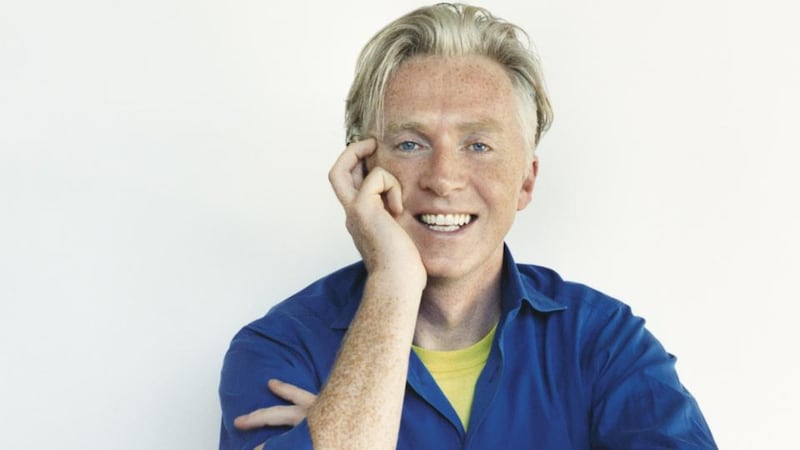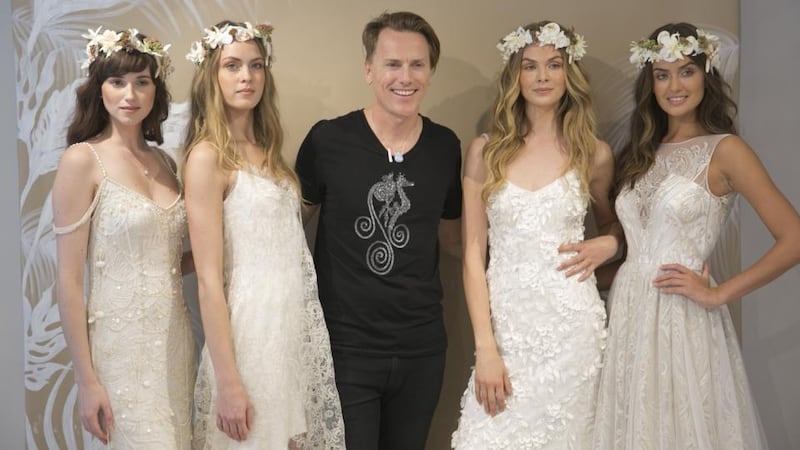Don O'Neill recalls his upbringing in Ballyheigue, Co Kerry as nothing short of magical.
“The castle behind my house is haunted,” he says. “ We would go up as kids on these hunts and searches in all sorts of weird places with flashlights digging for treasure and hoping that the ghosts wouldn’t see us. There was a place in the sand dunes where fairies were believed to come at night. And I grew up believing wholeheartedly in this mystical, magical world.
“On fine days the sun would be beaming across the water and sparkling and you can imagine the ocean being all choppy. And as a kid, I used to squint into the really bright part and dream. ‘Wouldn’t it be amazing if I could cut out that really sparkly bit and turn it into a dress?’”


Trained as a chef, O’Neill entered a newspaper competition and won tuition to fashion college in Dublin. When he graduated in 1987, he found the Irish fashion industry thriving.
"The scene was vivid," he says. "Incredible designers like John Rocha, Richard Lewis, Quin & Donnelly, working in Dublin, making their dresses in Dublin. There were factories making all sorts of exquisite garments. But I packed my bags and was off to London with £200 in my pocket. I didn't even start looking for a job in Ireland. "
Foot in the door
Five years later, O’Neill set his sights on Paris. “I headed off with literally my portfolio and a backpack and arrived in Paris with little to no French, no contacts, and £500 in my bag. Money was dwindling quickly and the only way I could really find a job was part-time working in McDonald’s! Somebody had told me that the only way to get in somewhere is to get your foot in the door.
"There are stories of me coming up with all sorts of lies and concoctions to meet designers. I lied my way into Chanel. I did the same thing at Yves Saint Laurent, where I told them that Pierre Bergé [Yves's partner] had told me to come in for an interview. I got to be interviewed by Loulou de La Falaise, who was Yves Saint Laurent's muse and costume jewellery designer. That ended very badly because she didn't like Irish men. But it did pay off eventually."
O'Neill was working at Christian Lacroix when he won the US Green Card Lottery."Things were finally starting to work out in Paris and I was really confused," he recalls. "I didn't know what to do and Mr Lacroix was extraordinary. My French was a disaster. I was using the tu form of the verb to address him, which you do not address him ever as tu – it's vous. I got reprimanded by the head of the atelier for my lack of respect of this man, to be using such a familiar form of the language with him.
Right as rain
“One day Christian was very upset and everybody was asked to leave. There was something wrong with his wife and it turned out that she had kidney stones. And an aunt of mine had kidney stones and I knew it was no big deal. And because I’ve no barriers I was like, ‘Oh, don’t worry about her. She’ll be grand and they’ll blow them out of her with little sonic waves and she’ll be right as rain by the end of the week.’
"And I guess he really appreciated that because that evening when I got home there was a phone call. He said: 'Don, you were so sweet today. Would you like to go out to dinner?' Anyway, I got to apologise to him for using the tu form of the verb all the time. And he said, 'I think it's the most charming thing ever and I absolutely love it, but of course I could never tell anyone that'."
O’Neill told him of his American Green Card dilemma. Lacroix sent him to an astrologer, who told him his future was in New York.
"Mr Lacroix gave me 10 handwritten letters of introduction to Donna Karen, to Oscar De La Renta, Marc Jacobs, Ralph Lauren. I basically met the creme de la creme. My design portfolio had become very Lacroix-influenced – exuberant, over the top, '80s fashion. And I arrive into New York when Calvin Klein is sort of coming to the peak of his fame and it's all about clean and modern. And there's this crazy, mad Irishman with this off-the-charts book that I think literally scared the crap out of the whole lot of them and nobody offered me a job."
Persistence prevailed, and O'Neill worked his way up to design director at Carmen Marc Valvo. He was headhunted by Badgley Mischka to revive its brand before the opportunity arose to create a new eveningwear label. So was born THEIA Couture, adored by women and celebrities worldwide. O'Neill has designed for Carrie Underwood and Oprah Winfrey, who wore THEIA to the 2012 Oscars.
Glamorous churchgoers
Young Philip Treacy was first introduced to the theatre of fashion in the church opposite his family's home in Ahascragh, Co Galway: "I used to watch all these weddings and I remember thinking how unbelievable it was, the way people got all dressed up and how glamorous they looked."
The second youngest of seven boys, Treacy credits his eldest sibling, his sister Marion, as his original muse. “I started making dresses and hats for my sister’s dolls. My mother had chickens, geese, pheasants and ducks, so all the ingredients of the hat were in my house.”
After studying fashion at NCAD, a scholarship to the RCA took Treacy to London, the city he has called home ever since.
“As a designer, you need to work where the business is,” he says. “So, you know, London is a cultural centre for design and fashion and art and for the whole kind of design world, really. There is London, New York, Paris and Milan. And unfortunately, as much as we would love if Dublin was, it isn’t. And it isn’t because it’s just too small.
“There are more people shopping in London. We have a huge Irish customer base, but they come to my shop in London. For a hat designer, it makes more sense to be in London than in New York because in London it is part of the psyche of dressing up.”
For today’s young fashion graduates, ‘making it’ as a designer is more difficult than ever, Treacy says.
“It’s hard, with a capital H. There are four times more students studying fashion than there were when I was doing it 20 years ago. But there aren’t four times more jobs. So you have to be self-sufficient, brilliant, able to design it, make it, finance it, show it, and then hope somebody buys it at the end to survive these days.
“But, you know, I came from nowhere, and I’ve been able to do it. So it’s not impossible, but it sure ain’t easy. We have to try, and trying is everything, and a superstar designer student can come from anywhere and can change all that – and sometimes that change is needed.”
True to her own tastes
One such young designer making waves in the international fashion scene is Danielle Romeril, who grew up in Dublin in the 1990s. Romeril's interest in fashion began when she realised she didn't have the same taste as everyone else.
"I remember sporting some pretty spaceman-like bomber jackets around the neighbourhood in Dún Laoghaire and having things shouted at me. I was friends with Merle O'Grady, the jewellery designer, and herself and her mother kind of taught me how to sew and make outfits.
“So it was about identity and putting a vision for yourself forward and being lucky enough to have friends who knew a bit more than I did.”
Romeril studied at Limerick School of Art & Design and London's RCA, before working with Alberta Ferretti in Italy. She launched her eponymous label with her SS13 collection, which was showcased at London Fashion Week.
“I started my business in Ireland and I think it is a really great place to be an entrepreneur,” she says. “But for the fashion industry specifically, there are many more opportunities in London. So it made sense to relocate there. I have been awarded NEWGEN support for six consecutive seasons. Also, through the Centre for Fashion Enterprise I have been awarded a studio space for two years with mentorship and a small amount of investment for the business.”
The British Fashion Council's prestigious NEWGEN scheme promotes and supports new designer business. Former recipients include Alexander McQueen, JW Anderson and Simone Rocha.
While Romeril says Ireland still has a way to go before being recognised internationally as a major pool for design talent, the industry is paying attention.
"I don't really think we've impacted in visual and design-led industries in the same way that we have in terms of literature and music, but it's definitely being noted. When Sarah Mower introduced me to Anna Wintour, she said 'here's another one of our Irish talents', in reference to JW and Simone, who had gone ahead of me."
Irish networking
Romeril says being Irish has benefitted her career. “I think it’s quite a nice way to network within a country through the kind of pre-existing Irish channels: people who I interned with in Paris, Irish people have come up through the ranks of design and they have had a chance to work with them again and again.
“So that’s what’s great about being from a small country with a large diaspora. There’s opportunities to kind of build relationships and grow with your peers.”
Don O’Neill echoes this sentiment.
“It has opened doors everywhere, even when I was in London in the late ’80s, when Irish relations with the UK were not at their strongest. I never ever sensed any animosity; it was always open arms and welcome. There is a love for Irish people around the world that is unprecedented, and it’s phenomenal to experience it. There’s something about the Irish character.
“And, of course, when you come to America . . . They just love everything about us, our heritage, our people and the culture, and any way that they can connect themselves to us or to Ireland.”











